Socket Preservation Graft After Tooth Extraction

A socket preservation graft is a way to preserve the socket (and jawbone density) after a tooth is extracted. This is often necessary to prevent teeth shifting, avoid the loss of bone inside of the jaw, and aid in the tooth replacement process.
Everything to know about a socket preservation graft
The following is everything to know about a socket preservation graft, including what the procedure is, why and when it is recommended, the risks factors, and what takes place during the procedure. This should help you feel more comfortable with the procedure if your dentist recommends one after tooth extraction.
What is a socket preservation graft?
A socket preservation graft is a type of bone graft that is performed during a tooth extraction procedure. The procedure is recommended to prevent oral health concerns and discomfort such as a dry socket or bone loss in the jaw. It is also an important step to avoiding the need for another bone graft procedure if the patient chooses to replace their tooth with a dental implant restoration.
What are the risks of not having a socket preservation graft?
Without a socket preservation graft after tooth extraction, a dry socket can form, which can lead to significant discomfort. In addition, bone loss in the jaw can occur after tooth extraction due to bone atrophy or as a result of a dry socket. A socket preservation graft helps prevent these concerns by filling the socket after the tooth is extracted. This can make the tooth replacement process easier as well, especially if the patient chooses a dental implant restoration.
In addition, a socket preservation graft is an easy procedure to perform as it can be performed immediately following a tooth extraction, so there is no need for a second, follow-up procedure. The procedure is also safe and highly effective.
What occurs during a socket preservation graft?
As mentioned, a socket preservation graft is performed during the same procedure as a tooth extraction. This means that there is no second visit required, which is typically the case with other types of bone graft procedures. During the socket preservation graft, the dental professional places the graft material in the socket. They then cover it with a membrane or collagen plug, followed by stitching up the area and allowing the mouth to heal.
What happens after a socket preservation graft?
The mouth should heal within a few weeks after tooth extraction and a socket preservation graft. To minimize discomfort during the recovery process, it is best to avoid anything that may cause irritation and practice good oral hygiene by brushing and using mouthwash regularly. Be sure to notify the oral surgeon if any concerns develop during the recovery process.
Find out more about socket preservation graft after tooth extraction
To learn more about socket preservation grafting, tooth extraction, or to schedule a visit, give us a call or send us a message today. We assist our patients throughout the entire process to ensure optimal safety. So why wait? Get in touch today to get started.
Request an appointment here: https://brighton.drjstearns.com or call Platte Valley Oral Surgery at (303) 997-0223 for an appointment in our Brighton office.
Check out what others are saying about our services on Yelp: Socket Preservation Grafting in Brighton, CO.
Recent Posts
You might have heard the term “wisdom tooth extraction” often. However, you might not know that every type of extraction does not require surgery. Some kinds only require a simple procedure. Keep reading to find out more about what a wisdom tooth extraction from an oral surgeon involves.In many cases, the wisdom teeth can be…
Corrective jaw surgery (also called orthognathic surgery) is performed by an oral surgeon to correct different forms of skeletal and dental issues, including jaw and teeth misalignment. The aim is to improve oral functions such as breathing, speaking, and eating. Although the surgery may improve the appearance of the patient's teeth significantly, corrective jaw surgery…
If you are experiencing symptoms like jaw pain and stiffness, TMJ disorder might be the problem. This disorder can have a significant impact on your physical and mental health. The condition generally worsens without treatment. A TMJ specialist is a trained and experienced professional who offers treatment for TMJ disorders. Continue reading to find out…
Bone grafting is a minor surgical treatment done under local anesthetic to replace depleted bone tissue. The grafting material may be inserted into a tooth socket just after a tooth is removed or at a location where a tooth has been absent for an extended period. Over the next few months, your body will produce…


